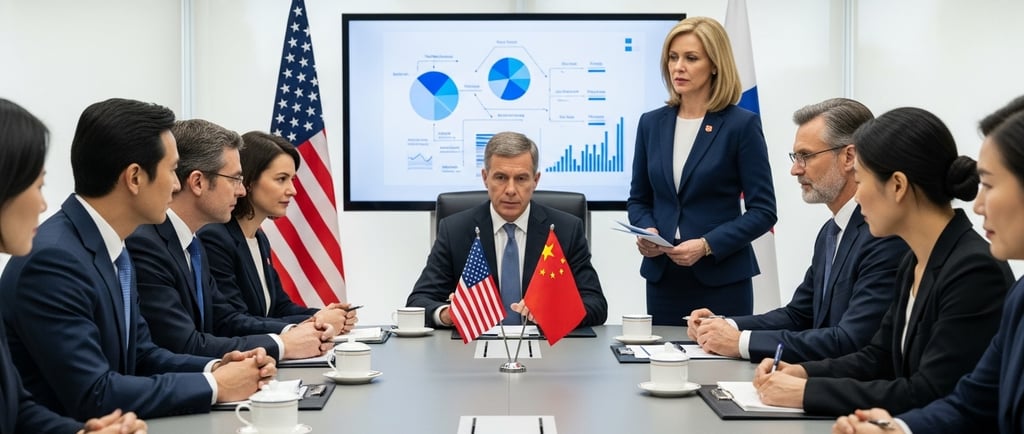The Price of Protection: Weighing the Pros and Cons of America's Tariff Strategy
The global economic landscape is being reshaped in real-time by a U.S. trade strategy that is both aggressive and unprecedented.
Cristian Ianowich
8/3/20253 min read


The global economic landscape is being reshaped in real-time by a U.S. trade strategy that is both aggressive and unprecedented. With recent landmark agreements with the European Union and Japan, and an ongoing standoff with China, the use of tariffs as a primary negotiation tool has moved from threat to reality.
The core idea is to leverage tariffs to force trading partners into new deals that are more favorable to American interests. But this high-stakes strategy comes with a complex set of consequences. While it can produce significant wins at the negotiating table, it also creates tangible economic ripple effects. Let's break down the positive and negative impacts of this approach on the U.S. economy.
The Positive Case: Forcing a "Fairer" Deal
From the administration's perspective, the primary goal of the tariff policy is to correct long-standing trade imbalances and protect American industries from what it considers unfair competition. The strategy is to make access to the U.S. market a privilege that must be earned through concessions. This has yielded several high-profile successes.
The EU Agreement: Facing a threatened 30% tariff, the European Union recently agreed to a landmark deal. The key benefits for the U.S. include a massive $750 billion commitment from the EU to purchase American energy and an additional $600 billion in new investments into the U.S. economy, both of which are expected to create American jobs.
The Japan Deal: Similarly, Japan agreed to a deal that includes a significant investment pledge and better terms for some U.S. goods, providing stability for key sectors like automotive manufacturing.
A New Revenue Stream: Proponents also point to the billions of dollars in revenue collected from the tariffs, arguing it helps offset the federal deficit and ensures foreign producers contribute their "fair share."
From a purely tactical standpoint, the strategy has been effective at forcing countries to the negotiating table and securing major investment and trade commitments that were previously unattainable.
The Negative Side: The Economic Fallout
While the negotiations yield headlines, economists and businesses point to significant, measurable downsides that affect the entire American economy.
1. Higher Prices for Consumers
Tariffs are, in effect, a tax on imported goods, and that cost is almost always passed down to the consumer. According to a recent analysis from Yale University's Budget Lab, the current tariffs will cost the average American household an estimated $2,400 annually due to higher prices. The impact is especially sharp on goods like:
Clothing and shoes (prices up nearly 40% in the short-term)
Electronics and appliances
Motor vehicles (prices up over 12%)
2. A Squeeze on American Businesses
The tariff strategy creates a two-way bind for U.S. companies. Those that rely on imported parts and materials now face higher production costs, making them less competitive. At the same time, countries hit with U.S. tariffs often retaliate by placing tariffs on American exports. This has been particularly damaging to the U.S. agricultural sector, which has lost access to key international markets.
3. A Drag on Overall Economic Growth
Higher costs and trade friction act as a brake on the economy. The same Yale study projects that the tariffs will result in -0.5% lower real GDP growth for both 2025 and 2026. In the long run, the U.S. economy is projected to be persistently smaller, with potential payroll employment being nearly 500,000 jobs lower by the end of 2025 than it would have been otherwise.
The Unresolved Standoff: The Case of China
The most significant unresolved piece of the puzzle remains China. Currently, a "tariff pause" is in effect, with the U.S. maintaining a 30% tariff on Chinese imports and China imposing a 10% duty on American goods. While recent talks have been described as "constructive," no final deal has been reached. This ongoing uncertainty between the world's two largest economies remains a major source of global economic instability.
In conclusion, America's current trade strategy is a bold gamble. It has proven to be a powerful lever in negotiations, securing major concessions and investments. However, those victories come at a direct cost to American households and businesses. The central economic debate is whether the long-term benefits of these new deals will ultimately outweigh the immediate, and significant, price of protection.
